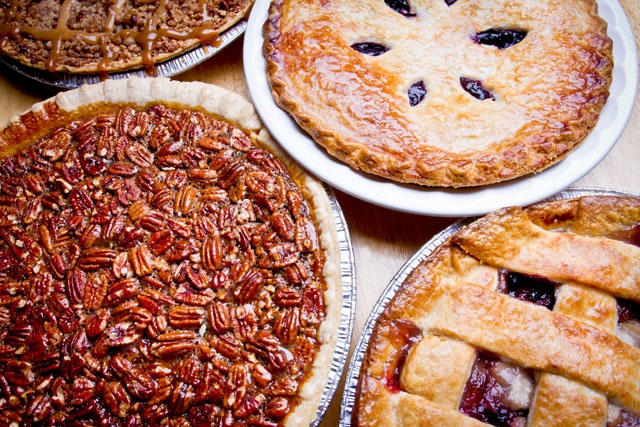French macrons are the queens of cookies. Their beautiful, vibrant colors coupled with crisp outside and soft, chewy inside compliment any table. They are not only beautiful and delicious, but they are also complicated. Most novice bakers do not even attempt to make these little treats. The daunting task of baking macarons can be defeated by time, patience, practice, and preparation.
Objectives:
1. Learn about the history and characteristics of classic macarons.
2. Learn tips and strategies for perfect macarons.
3. Learn how to avoid and combat common mistakes.
4. Complete a batch of basic almond macarons.
History of the Macaron:
The macaron (pronounced mac-a-roon) is an airy meringue sandwich cookie created primarily out of ground almonds, superfine sugar, and egg whites. They are commonly filled with jam, gnashes, and buttercream. Though macarons are widely considered French, there is a dispute over the origin of the cookie. It is possible they were originally Italian. Some historians believe the confection was brought by Catherine d'Medici's Italian pastry chefs when she married King Henry II in 1593. Whatever the true origins may be, it can be stated the French have laid claim to the little delicacies.
Regional Variations:
The Macaron is popular not only in France, but also in other parts of Europe and Asia. In Sweden macarons are known as Luxemburgeri, and they are said to be smaller, lighter, and fluffier than French macarons. Japan has a variety that uses ground peanuts instead of almonds, and a popular Korean flavor uses green tea powder for a regional twist.
Baking the French Macaron:
1. It is always important to follow a recipe precisely, and this is never truer than with the French macaron.
2. Always weigh your ingredients and find a recipe that states weight rather than amount. For instance, "3 egg whites" is much less precise than "50g egg whites." The slightest deviation can foul your entire recipe.
3. Buy ground almonds. Do not attempt to grind them with your own kitchen equipment. To successfully bake a beautiful, airy macaron you will need the almond meal to be as fine as possible.
4. Even if you buy your almond flour, sift it before measuring. Only measure what you will use after you have sifted out any large pieces.
5. Age your egg whites. This may sound odd to most people, but it will help to reduce moisture while retaining the protein bonds of the egg whites. Simply divide the eggs and place the egg whites in a ceramic bowl and cover loosely with a paper towel and leave at room temperature for 24 - 48 hours before using.
6. When whipping your egg whites and sugar, they should form peaks. This means that you should be able to hold the bowl upside down above your head without the batter slipping out.
7. All ingredients must always be used only at room temperature. Macarons are finicky and can come out wrong if there is too great a variation in temperature.
8. Do not over fold your batter. When you add the almond meal to the meringue, stir as little as possible.
9. In order to attain the right sized little cookie disks, spoon your batter into a piping bag and pipe onto the silicone mat.
10. Allow your macarons to sit on the baking sheet for one hour before baking. They should form skins and no longer be shiny. If you allow them to sit for too long, they will over dry and crack. Too little time will not allow them to dry fully.
11. Use a silicone baking sheet to line your pan instead of parchment paper. These cookies are very delicate and it will be difficult to lift them from any other surface.
Flavors:
Many regions boast local flavors, such as green tea macarons in Korea or the honey macarons of Amiens. Most bakeries that carry macarons have a variety of flavors and colors to compliment a cup of tea. Traditional flavors include raspberry, pistachio, caramel, and chocolate. Some newer popular flavors would include matcha (green tea powder) and grapefruit.
Adding Flavor:
There are many delicious flavors of macarons, as described above, and when adding flavor to your macaron recipe, it is not as simple as adding a few drops of vanilla. Macarons are very particular little cookies, so every flavor will require its own recipe. You can find these recipes online or in cookbooks. Start with the most basic macaron recipe first before experimenting.
Traditional Macarons (Almond):
Ingredients
-
5g dehydrated egg white powder
-
28g granulated sugar
-
225g confectioners (powdered) sugar
-
125g almond meal
-
100g aged egg whites
Note: Egg white powder should be in any grocery store, but if it is not accessible nearby it is always available online. Do not substitute for meringue powder.
Directions
1. Preheat oven to 290°- 300°.
2. Mix egg white powder and granulated sugar and set aside.
3. Sift together almond meal and powdered sugar and set aside.
4. Weigh out your aged egg whites and beat on a low speed until frothy and foamy.
5. Slowly add powdered sugar and egg whites (sprinkle them in).
6. Increase to medium speed and beat until meringue forms. The meringue will be firm. It will form glossy peaks but not stiff peaks.
7. Beat in food coloring.
8. Fold in ¹?? of the almond meal and granulated sugar at a time. Do not over fold.
9. Spoon mixture into a piping bag and squeeze small disks onto silicone baking mat (or a cookie sheet).
10. Tap cookie sheet firmly on the counter several times after squeezing the cookie meringue onto the sheet. This should bring any air bubbles to the top of the cookie. Pop any bubbles with a pin.
11. Allow the cookies to rest for about an hour (you may need less time if you are in a particularly dry climate).
12. Bake for approximately 15 minutes.
13. The meringue should be set and not overly moist. Wet meringue will collapse as it cools.
14. It is better to over bake them slightly than to under bake them. The outside should be crisp. As the cookies age over 1 - 2 days, moisture will be absorbed from the air to remove a little of the crunchiness that comes with a fresh baked macaron.
15. Fill macaroons with desired filling and sandwich one on top of the other.
Conclusion:
Macarons are delicious and known to be complicated little treats. After practice, experimentation, and mere trial and error, you should be able to prefect the art of the macaron and have your guests talking about your baking mastery for years to come. The most important part of baking the macaron is to make sure you plan ahead. The best macarons use aged egg whites (1 - 2 days), use one day for baking, and then sit for a day or two before serving. Macarons may take up to five days to prepare but they are worth every minute!
Simple Twists on Old Favorites
There are many well-loved, classic cookies out there. Sometimes the best desserts are the most comforting, familiar ones. There are a few ways to add a few twists to these old favorites that will mix both familiar pleasure and exciting innovation.
Objectives:
1. Learn a few 'secret' ingredients that can make all the difference.
2. Learn simple ways to make any old recipe new again.
2. Make a batch of your favorite cookies with a twist.
Oatmeal:
Oatmeal can be blended and used to replace half of the flour in a recipe. It will make your cookies thicker and more flavorful without much of a noticeable difference. The oatmeal can also be left whole (as in a traditional oatmeal raisin cookie) and used in cookies such as chocolate chip. Oatmeal chocolate chip pecan is not the most traditional of cookies but it is the combination of two old favorites. This is a good choice for people who don't like raisins but who love oatmeal.
Cream of Tartar:
Cream of tartar is sometimes used in traditional cookie recipes. It can also be used as a replacement for baking powder when combined with baking soda. The white powder, found in the spice section of your local grocery store, acts as a volumizing agent that interacts with beaten eggs. It is used to make the cookies lighter and not so heavy or dense. You can add just a half a teaspoon to make a difference in your cookies.
Coconut Oil:
Coconut oil has experienced a resurgence of interest in the past couple of years along with all other coconut products. Entire books have been written on the benefits of coconut oil, and it is sometimes touted as a miracle substance for hair, skin, nails, teeth, weight loss, and so on. The extra virgin cold-pressed variety is the most pure and contains the most health benefits and flavor. Substituting some of your butter for coconut oil will give your cookies a unique flavor that will leave your guests asking your "secret." Coconut oil has a milder flavor than shredded coconut and without the added sugar it will not disrupt the balance of your cookie. It will simply take the place of some of the fats of the butter without changing the outcome of the texture. A great little twist on an old favorite was never easier or more delicious.
Mix Chocolate Sizes:
Do not be afraid to use some regular-sized chocolate chips with some miniature-sized ones as well. This will create difference in your cookie bites. The smaller chips will create the illusion of there being more chocolate without compromising the ratio of chocolate to batter.
Switch-up your Chocolate:
Go for milk chocolate coupled with macadamia nuts instead of the classic white chocolate macadamia. The macadamia nut is a largely undervalued nut although it has a smooth, mild flavor and a welcome crunch. It is a bit more expensive than the more popular nuts such as peanuts and walnuts but is a nice addition to a good cookie. The traditional white chocolate macadamia nut cookies are not always a favorite with a large crowd since many people are skeptical of the light chocolate. Milk chocolate, which is much more familiar, actually compliments the macadamia nut very well and is an uncommon twist on an old classic. Another good chocolate switch would be to use dark chocolate instead of milk chocolate in some cookies. You could do a dark chocolate chunk with pecans to add some richness, but be prepared that some people may not like the extra bitterness of the dark chocolate.
Sea Salt:
Sea Salt is made by dehydrating sea water and is generally sold in larger granules than mined table salt. Many chefs prefer to use sea salt because they believe it has a richer flavor due to the other minerals present in sea water. If you add a little sea salt to top your cookie or even mix inside, it will give the cookie a sweet and salty flavor that is not typically characteristic of a traditional cookie. The salt enhances the other flavors of the cookie while adding a complex one of its own.
Ideas in Action:
The following cookies are new twists on old favorites, combining some to the special ingredients listed above. Try one of them and see how a little change can make a big difference.
Macadamia Milk Chocolate with Coconut Oil:
These cookies are delightfully crisp on the outside and chewy on the inside. The coconut enhances the flavor of the chocolate without being overpowering.
Ingredients
-
1 ¾ cup all-purpose flour
-
1 teaspoon baking powder
-
¼ cup baking soda
-
¼ teaspoon salt
-
½ cup coconut oil (virgin or extra virgin)
-
2 large eggs
-
½ cup white sugar
-
½ cup brown sugar (packed and heaping)
-
2 teaspoons vanilla extract
-
¾ cup semisweet chocolate chips
-
½ cup mini semisweet chocolate chips
-
1 cup macadamia nuts
Directions
1. Whisk dry ingredients (flour, baking powder, salt) in a medium mixing bowl and set aside.
2. Beat together coconut oil and sugar in another mixing bowl until creamy. Add vanilla and eggs one at a time. Beat mixture until well combined.
3. Pour in dry ingredients slowly. Mix well after each addition.
4. Stir in chocolate chips and macadamia nuts.
5. Wrap dough in plastic wrap and place in the refrigerator for an hour to chill.
6. Preheat oven to 375° and line two cookie sheets with parchment paper.
7. Drop tablespoon sized dough balls on the parchment paper.
8. Bake for 8 - 10 minutes or until the edges of the cookies turn golden brown.
9. Cool completely on the cookie sheets.
Note: if you do not like the taste of coconut but would still like to try the crispy and chewy coconut oil cookies, you can use refined coconut oil (not virgin or extra virgin) which does not have a distinct coconut flavor.
Sea-salted Ginger Cookies:
The gingersnap is a great, milk-dunking cookie. Packaged ginger snaps tend to be rather hard whereas the homemade versions tend to be chewier. This recipe with a twist will not only make for a chewy ginger cookie, but it will also combine sweet and salty with the bite of ginger.
Ingredients
-
¾ cup butter, softened
-
½ cup firmly packed brown sugar
-
½ cup granulated sugar
-
½ teaspoon baking soda
-
½ teaspoon cream of tartar
-
1 large egg
-
2 cups all-purpose flour
-
¹?? cup molasses
-
1 teaspoon ground cinnamon
-
2 teaspoons ground ginger
-
½ teaspoon salt
-
½ teaspoon sea salt
-
1 – 1 ½ teaspoons sea salt (to sprinkle on top of cookies)
Directions
1. Cream butter and sugars in a mixing bowl and mix until well incorporated.
2. Beat egg and molasses together and add to the sugar and butter mixture.
3. Add cinnamon, baking soda, regular salt, and ginger and mix well.
4. Add flour and incorporate thoroughly.
5. Refrigerate the dough for 1 - 2 hours.
6. Preheat oven to 350°.
7. Line cookie sheet with parchment paper.
8. Drop cookies in tablespoon-sized balls on the parchment paper.
9. Sprinkle with sea salt and press down gently.
10. Bake for 9 - 12 minutes.
Conclusion:
You can make any traditional cookie recipe your own just by adding a special ingredient or two. When you make your own cookies, you will never be constrained by the typical choices available already made at the grocery store or bakery. Just experiment and have a good time.




























